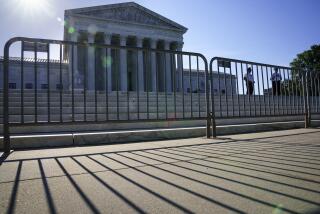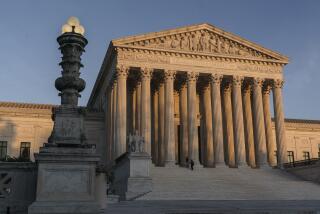NEWS ANALYSIS : Breyer Fits the Mold of Status Quo Justices : Judiciary: Clinton is following the path of his Republican predecessors by choosing a consensus-builder.
- Share via
WASHINGTON — The nomination of Judge Stephen G. Breyer to the Supreme Court, like the choice of Ruth Bader Ginsburg last year, appears to put President Clinton on the same path as his Republican predecessors, who sought to build a court more likely to adhere to the status quo than to boldly reshape the law or expand individual rights.
Breyer and Ginsburg, like most recent Republican presidential nominees, are careful, moderate judges inclined to make consensus rulings. The trend, which extends back at least to the 1987 defeat of Judge Robert H. Bork’s nomination, has created a high court whose first instinct is to avoid dramatic decisions.
“It is the downsizing of the Supreme Court,” said Georgetown University law professor Mark Tushnet. Stacked with low-profile jurists, the court “is avoiding the high-profile issues,” he said.
It stands in a marked contrast to the court led by former California Gov. Earl Warren, which often moved boldly to correct what it saw as social evils by writing new constitutional rules. It was the Warren court, for example, that 40 years ago this week struck down racial segregation in the schools with the landmark ruling in Brown vs. the Board of Education of Topeka, Kan.
But whether the issue is abortion or affirmative action, the prime constitutional battles of the 1980s, or the emerging 1990s disputes over gay rights and the “right to die” through assisted suicide, the current high court is inclined to defer to the decisions of others, especially elected lawmakers.
Indeed, in this term the justices have shunned controversies of all sort and are expected to issue written decisions in only 85 cases, the lowest number since 1961.
In one sense, the trend toward centrist judges reflects a reluctance by presidents to nominate candidates who will set off sparks during the Senate confirmation process.
Breyer won the nod from Clinton late Friday afternoon only after some Senate Republicans had vowed to fight the nomination of Interior Secretary Bruce Babbitt, who was seen as a bolder and more liberal choice.
Breyer appears to be “one more vote to keep the court on a middle course,” said University of Virginia law professor A. E. Dick Howard. “He is not likely to be a vote for innovation.”
During the years when the Republicans occupied the White House, the process worked in reverse. Senate Democrats did their best to block strongly conservative nominees.
In 1986, President Ronald Reagan, at the height of his power, elevated conservative Justice William H. Rehnquist to lead the court and appointed the strongly conservative Justice Antonin Scalia. Senate Democrats mustered 33 votes against Rehnquist but failed to stop either confirmation.
But the next year, Reagan tried to add Bork, another bold conservative. If confirmed, he would certainly have joined Rehnquist and Scalia in an effort to overturn the Roe vs. Wade decision on abortion and to outlaw any preferential treatment for racial minorities.
But the Democrat-controlled Senate defeated the Bork nomination, and Reagan then turned to a low-key, more moderate appeals court judge, Anthony M. Kennedy of Sacramento, who won a unanimous confirmation.
In 1990, President George Bush wanted to avoid a Senate fight over abortion and selected a so-called “stealth candidate,” Judge David H. Souter of New Hampshire. With no written record on controversies, Souter easily won over Senate Democrats.
In 1992, Kennedy and Souter combined to preserve the status quo in two key areas. They cast the deciding votes against overturning the Roe vs. Wade decision and permitting prayers at school graduations.
While many conservatives were frustrated by the failure of GOP appointees to change the law on abortion, school prayer and affirmative action, liberals may well find themselves disappointed in the future with Clinton’s nominees.
Looming on the horizon are two controversies that will test the direction of the new high court.
In several cases, gay-rights lawyers are challenging government policies that discriminate among individuals based on their sexual orientation. These include not only the military’s continued ban on open homosexuals, but other laws involving marriage, adoptions, employment and survivor’s benefits.
The high court has not ruled squarely on whether government discrimination against homosexuals is constitutional. In recent cases involving the military, the justices have simply ducked the issue by refusing to hear appeals filed by gay service personnel.
Meanwhile, a federal judge in Seattle has ruled for the first time that the Constitution gives a terminally ill person a right to die through assisted suicide. In her opinion, Judge Barbara Rothstein cited the “right to privacy” principle set out in the high court’s abortion decisions and then extended the doctrine to cover the choice of ending one’s own life.
If the high court were to adopt Rothstein’s view, it would sweep aside laws nationwide that prevent doctors and others from aiding in suicides.
While no one can forecast how a Justice Breyer would rule on such issues, the veteran Boston jurist has not shown a tendency to expand the Constitution into new areas.
“He is a good, gray choice who will not do anything dramatic in the immediate future,” Tushnet predicted. “He will keep things going the way they are.”
As a scholar, Breyer has written mostly about issues involving the cost of health and safety regulations, rather than debating the reach of the Constitution and its protection of individual rights.
“He certainly doesn’t seem to have an activist agenda,” Howard said. “I don’t think he will strike out in new directions. He is likely to be the solid craftsman who can shore up the center.”
More to Read
Get the L.A. Times Politics newsletter
Deeply reported insights into legislation, politics and policy from Sacramento, Washington and beyond. In your inbox twice per week.
You may occasionally receive promotional content from the Los Angeles Times.











